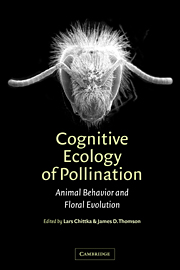Book contents
- Frontmatter
- Contents
- List of contributors
- Preface
- 1 The effect of variation among floral traits on the flower constancy of pollinators
- 2 Behavioral and neural mechanisms of learning and memory as determinants of flower constancy
- 3 Subjective evaluation and choice behavior by nectar-and pollen-collecting bees
- 4 Honeybee vision and floral displays:from detection to close-up recognition
- 5 Floral scent, olfaction, and scent-driven foraging behavior
- 6 Adaptation, constraint, and chance in the evolution of flower color and pollinator color vision
- 7 Foraging and spatial learning in hummingbirds
- 8 Bats as pollinators: foraging energetics and floral adaptations
- 9 Vision and learning in some neglected pollinators: beetles, flies, moths, and butterflies
- 10 Pollinator individuality: when does it matter?
- 11 Effects of predation risk on pollinators and plants
- 12 Pollinator preference, frequency dependence, and floral evolution
- 13 Pollinator-mediated assortative mating: causes and consequences
- 14 Behavioural responses of pollinators to variation in floral display size and their influences on the evolution of floral traits
- 15 The effects of floral design and display on pollinator economics and pollen dispersal
- 16 Pollinator behavior and plant speciation: looking beyond the “ethological isolation” paradigm
- Index
7 - Foraging and spatial learning in hummingbirds
Published online by Cambridge University Press: 13 August 2009
- Frontmatter
- Contents
- List of contributors
- Preface
- 1 The effect of variation among floral traits on the flower constancy of pollinators
- 2 Behavioral and neural mechanisms of learning and memory as determinants of flower constancy
- 3 Subjective evaluation and choice behavior by nectar-and pollen-collecting bees
- 4 Honeybee vision and floral displays:from detection to close-up recognition
- 5 Floral scent, olfaction, and scent-driven foraging behavior
- 6 Adaptation, constraint, and chance in the evolution of flower color and pollinator color vision
- 7 Foraging and spatial learning in hummingbirds
- 8 Bats as pollinators: foraging energetics and floral adaptations
- 9 Vision and learning in some neglected pollinators: beetles, flies, moths, and butterflies
- 10 Pollinator individuality: when does it matter?
- 11 Effects of predation risk on pollinators and plants
- 12 Pollinator preference, frequency dependence, and floral evolution
- 13 Pollinator-mediated assortative mating: causes and consequences
- 14 Behavioural responses of pollinators to variation in floral display size and their influences on the evolution of floral traits
- 15 The effects of floral design and display on pollinator economics and pollen dispersal
- 16 Pollinator behavior and plant speciation: looking beyond the “ethological isolation” paradigm
- Index
Summary
Enthusiasm for optimal foraging theory in the 1970s and 1980s stimulated much work on foraging by bees and, to a lesser extent, hummingbirds. These animals were assumed to be energetically stressed because they were nectarivorous, small, and dependent on costly forms of flight. Researchers sought to explain foraging in terms of movement patterns that saved energy. For example, Pyke (1981) derived movement rules both within and between inflorescences. He compared observed directions and distances of movements following departure from a flower to optimal predictions, under the assumption that the animals should maximize their net rate of energy intake. Pyke (and many others) also assumed that animals would have imperfect knowledge about their environments, particularly with regard to predictions as to what and where to find food in the future. In addition to using statistical rules (Pyke 1984), such animals should always sample in order to track an ever-changing world. Despite the power and appeal of this viewpoint, we now see growing evidence that simple rules and patterns alone cannot explain foraging in hummingbirds. Here, we review how learning and memory influence hummingbird foraging and how memory might affect the ways in which hummingbirds pollinate plants.
Much of a hummingbird's diet is derived from the nectar of flowers that, in turn, rely on hummingbirds for pollination. These flowers frequently provide only a few mg of sugar daily (Kodric-Brown & Brown 1978). Hummingbirds therefore must visit many flowers on each feeding bout, transferring pollen among flowers in the process.
- Type
- Chapter
- Information
- Cognitive Ecology of PollinationAnimal Behaviour and Floral Evolution, pp. 127 - 147Publisher: Cambridge University PressPrint publication year: 2001
- 14
- Cited by



